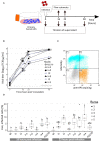Blood B Cell Depletion Reflects Immunosuppression Induced by Live-Attenuated Infectious Bursal Disease Vaccines
- PMID: 35558891
- PMCID: PMC9087897
- DOI: 10.3389/fvets.2022.871549
Blood B Cell Depletion Reflects Immunosuppression Induced by Live-Attenuated Infectious Bursal Disease Vaccines
Erratum in
-
Erratum: Blood B cell depletion reflects immunosuppression induced by live-attenuated infectious bursal disease vaccines.Front Vet Sci. 2023 Jun 27;10:1236998. doi: 10.3389/fvets.2023.1236998. eCollection 2023. Front Vet Sci. 2023. PMID: 37441558 Free PMC article.
Abstract
Immunosuppression in poultry production is a recurrent problem worldwide, and one of the major viral immunosuppressive agents is Infectious Bursal Disease Virus (IBDV). IBDV infections are mostly controlled by using live-attenuated vaccines. Live-attenuated Infectious Bursal Disease (IBD) vaccine candidates are classified as "mild," "intermediate," "intermediate-plus" or "hot" based on their residual immunosuppressive properties. The immunosuppression protocol described by the European Pharmacopoeia (Ph. Eur.) uses a lethal Newcastle Disease Virus (NDV) infectious challenge to measure the interference of a given IBDV vaccine candidate on NDV vaccine immune response. A Ph. Eur.-derived protocol was thus implemented to quantify immunosuppression induced by one mild, two intermediate, and four intermediate-plus live-attenuated IBD vaccines as well as a pathogenic viral strain. This protocol confirmed the respective immunosuppressive properties of those vaccines and virus. In the search for a more ethical alternative to Ph. Eur.-based protocols, two strategies were explored. First, ex vivo viral replication of those vaccines and the pathogenic strain in stimulated chicken primary bursal cells was assessed. Replication levels were not strictly correlated to immunosuppression observed in vivo. Second, changes in blood leukocyte counts in chicks were monitored using a Ph. Eur. - type protocol prior to lethal NDV challenge. In case of intermediate-plus vaccines, the drop in B cells counts was more severe. Counting blood B cells may thus represent a highly quantitative, faster, and ethical strategy than NDV challenge to assess the immunosuppression induced in chickens by live-attenuated IBD vaccines.
Keywords: B cells; IBDV; immunosuppression; live-attenuated vaccine; replication; vaccine safety.
Copyright © 2022 Courtillon, Allée, Amelot, Keita, Bougeard, Härtle, Rouby, Eterradossi and Soubies.
Conflict of interest statement
The authors declare that the research was conducted in the absence of any commercial or financial relationships that could be construed as a potential conflict of interest.
Figures



Similar articles
-
Efficacy of HVT-IBD vector vaccine compared to attenuated live vaccine using in-ovo vaccination against a Korean very virulent IBDV in commercial broiler chickens.Poult Sci. 2016 May;95(5):1020-4. doi: 10.3382/ps/pew042. Epub 2016 Mar 4. Poult Sci. 2016. PMID: 26944964 Clinical Trial.
-
In Ovo and Day of Hatch Application of a Live Infectious Bursal Disease Virus Vaccine to Commercial Broilers.Avian Dis. 2019 Dec;63(4):713-720. doi: 10.1637/aviandiseases-D-19-00087. Avian Dis. 2019. PMID: 31865687
-
Bilateral effects of vaccination against infectious bursal disease and Newcastle disease in specific-pathogen-free layers and commercial broiler chickens.Avian Dis. 2007 Mar;51(1):14-20. doi: 10.1637/0005-2086(2007)051[0014:BEOVAI]2.0.CO;2. Avian Dis. 2007. PMID: 17461261 Clinical Trial.
-
Current status of vaccines against infectious bursal disease.Avian Pathol. 2012;41(2):133-9. doi: 10.1080/03079457.2012.661403. Avian Pathol. 2012. PMID: 22515532 Review.
-
Reverse genetics approaches for live-attenuated vaccine development of infectious bursal disease virus.Curr Opin Virol. 2020 Oct;44:139-144. doi: 10.1016/j.coviro.2020.08.001. Epub 2020 Sep 3. Curr Opin Virol. 2020. PMID: 32892072 Review.
Cited by
-
The complete protections induced by the oil emulsion vaccines of the novel variant infectious bursal disease viruses against the homologous challenges indicating the important roles of both VP2 and VP1 in the antigenicity and pathogenicity of the virus.Front Vet Sci. 2024 Aug 29;11:1466099. doi: 10.3389/fvets.2024.1466099. eCollection 2024. Front Vet Sci. 2024. PMID: 39268520 Free PMC article.
-
Synergistic Immunosuppression of Avian Leukosis Virus Subgroup J and Infectious Bursal Disease Virus Is Responsible for Enhanced Pathogenicity.Viruses. 2022 Oct 21;14(10):2312. doi: 10.3390/v14102312. Viruses. 2022. PMID: 36298866 Free PMC article.
-
Development and evaluation of immunogenicity and protective efficacy of two recombinant attenuated newcastle disease viruses expressing the VP2 protein of infectious bursal disease virus.Poult Sci. 2025 Jul;104(7):105253. doi: 10.1016/j.psj.2025.105253. Epub 2025 May 8. Poult Sci. 2025. PMID: 40339237 Free PMC article.
-
Infectious bursal disease virus: predicting viral pathotype using machine learning models focused on early changes in total blood cell counts.Vet Res. 2023 Oct 30;54(1):101. doi: 10.1186/s13567-023-01222-5. Vet Res. 2023. PMID: 37904195 Free PMC article.
References
-
- Ratcliffe MJH, Härtle S. Chapter 4 - B cells, the bursa of fabricius and the generation of antibody repertoires. In: Schat KA, Kaspers B, Kaiser P. editors. Avian Immunology. 2nd ed. Boston, MA: Academic Press; (2014). p. 65–89.
-
- Eterradossi N, Saif YM. Infectious bursal disease. In: Swayne DE, Boulianne M, Logue CM, McDougald LR, Nair V, Suarez DL. editors. Diseases of Poultry. Hoboken: Wiley-Blackwell; (2020). p. 257–83.
-
- Infectious Bursal disease (Gumboro disease) . In: Manual of Diagnostic Tests and Vaccines for Terrestrial Animals. Paris: Organisation mondiale de la santé animale; (2021). p. 931–51.
LinkOut - more resources
Full Text Sources

